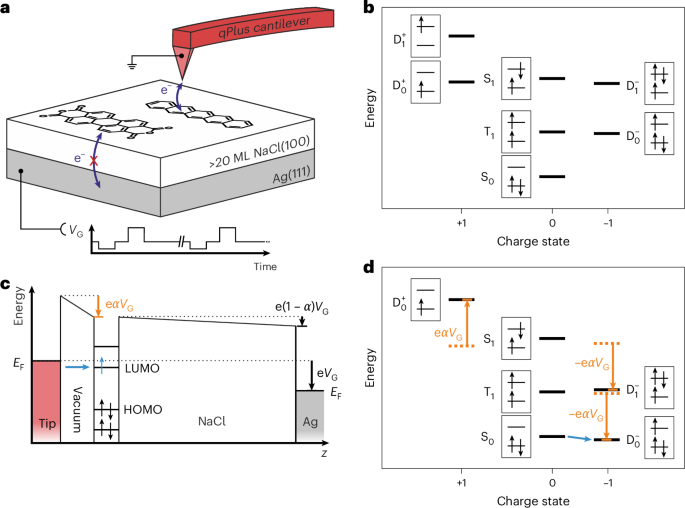受控单电子转移实现了单个分子的时间分辨激发态光谱学
IF 34.9
1区 材料科学
Q1 MATERIALS SCIENCE, MULTIDISCIPLINARY
引用次数: 0
摘要
越来越多的基于扫描探针的光谱技术为研究单分子的各种电子特性提供了机会。通常情况下,这些实验只能研究所有电子跃迁的一个子集,因此无法将测量到的量明确地归属于特定的量子跃迁。在这里,我们开发了一种单分子光谱学方法,它能够获得许多不同类型的量子跃迁,包括辐射、非辐射和氧化还原(即与电荷有关的跃迁)。我们的方法依赖于受控的交替单电荷附着和脱离。为了读出,自旋态被映射为电荷态,我们可以通过原子力显微镜检测电荷态。我们可以确定单个分子的基态和激发态的相对能量,并在确定的激发态下制备分子。在对五碳烯进行原理验证后,我们将该技术应用于 PTCDA,其扫描探针发光的解释一直存在争议。该方法可用于引导、理解和设计尖端诱导的化学反应以及单个分子的磷光和荧光。本文章由计算机程序翻译,如有差异,请以英文原文为准。


Controlled single-electron transfer enables time-resolved excited-state spectroscopy of individual molecules
An increasing number of scanning-probe-based spectroscopic techniques provides access to diverse electronic properties of single molecules. Typically, these experiments can only study a subset of all electronic transitions, which obscures the unambiguous assignment of measured quantities to specific quantum transitions. Here we develop a single-molecule spectroscopy that enables the access to many quantum transitions of different types, including radiative, non-radiative and redox, that is, charge-related, transitions. Our method relies on controlled alternating single-charge attachment and detachment. For read-out, the spin states are mapped to charge states, which we can detect by atomic force microscopy. We can determine the relative energies of ground and excited states of an individual molecule and can prepare the molecule in defined excited states. After a proof-of-principle demonstration of the technique on pentacene, we apply it to PTCDA, the scanning-probe luminescence of which has been interpreted controversially. The method may be used to guide, understand and engineer tip-induced chemical reactions as well as phosphorescence and fluorescence of individual molecules. A sophisticated atomic force microscopy experiment enables a time-resolved tunnelling spectroscopy method that provides access to excited states of singles molecules. It quantifies the transition energies and can prepare a molecule in a specific excited state.
求助全文
通过发布文献求助,成功后即可免费获取论文全文。
去求助
来源期刊

Nature nanotechnology
工程技术-材料科学:综合
CiteScore
59.70
自引率
0.80%
发文量
196
审稿时长
4-8 weeks
期刊介绍:
Nature Nanotechnology is a prestigious journal that publishes high-quality papers in various areas of nanoscience and nanotechnology. The journal focuses on the design, characterization, and production of structures, devices, and systems that manipulate and control materials at atomic, molecular, and macromolecular scales. It encompasses both bottom-up and top-down approaches, as well as their combinations.
Furthermore, Nature Nanotechnology fosters the exchange of ideas among researchers from diverse disciplines such as chemistry, physics, material science, biomedical research, engineering, and more. It promotes collaboration at the forefront of this multidisciplinary field. The journal covers a wide range of topics, from fundamental research in physics, chemistry, and biology, including computational work and simulations, to the development of innovative devices and technologies for various industrial sectors such as information technology, medicine, manufacturing, high-performance materials, energy, and environmental technologies. It includes coverage of organic, inorganic, and hybrid materials.
 求助内容:
求助内容: 应助结果提醒方式:
应助结果提醒方式:


